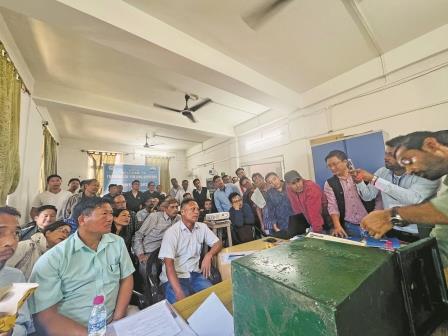Latest News
-
 Governor presides over 23rd Convocation of RGU
Governor presides over 23rd Convocation of RGU
-
Stage set for 12th general elections to PRIs, …
-
NCP wins 109 GP seats unopposed; Toko Tatung lauds unprecedented…
-
Governor commends Eastern Army Commander for peace along borders
-
 Namdapha Butterfly Festival concludes with over 100 species sighted
Namdapha Butterfly Festival concludes with over 100 species sighted
-
ANYA issues ultimatum to govt to resolve Lada-Sarli Frontier Highway…
-
IFCSAP withdraws third phase of agitation following govt’s positive assurance
-
 First phase training for Presiding and Polling Officers conducted
First phase training for Presiding and Polling Officers conducted
-
 Election Observer holds meeting with stakeholders ahead of Panchayat polls
Election Observer holds meeting with stakeholders ahead of Panchayat polls
-
Arunachal SEC introduces on-the-spot voting facility for personnel …
28th May 2022 11:05:PM State
Major General Suresh Chandra Mohanty, AVSM
The Indian Home Minister Mr Amit Shah during his recent visit to Namsai in Arunachal Pradesh most fittingly termed the State as the ‘Crown Jewel of India’. From the vaguely territorial definition of North Eastern Frontier Agency(earlier known as North Eastern Frontier Tract), encompassing areas of present-day Assam, Arunachal Pradesh and Nagaland to being a union territory on 20 Jan 1972 and subsequently being granted statehood on 20 Feb 1987, the State has come a long way in terms of a distinct ethnocultural and geographic identity, development, infrastructure and prosperity. During my telephonic interaction with a number of service providers located across metro cities in India over the last year and a half, I was distressed to find many learned and so-called English-speaking intellectuals unaware of where Itanagar was and had a rather vague idea about Arunachal Pradesh as a State. Hence the deplorable ignorance of 24year old You Tuber Paras Singh, from Punjab, with a twitter following of 30,000, who made derogatory remarks not only about the people of the state but also racist remarks against a sitting MLA in May last year, is not exactly a case of one-off aberration and stereotyped perception of North East India. The subsequent clamor by over 30 organisations in the North East for inclusion of history and cultural knowledge about North Eastern States in the educational curriculum thus has enormous merit. It is to the credit of the state police to have rounded him within 48 hours and bringing him to Itanagar to face legal action.
Strategic Significance
Arunachal Pradesh happens to be geographically the largest of the North Eastern States with an area of over 83,000 Sq km and shares borders with Tibet, Bhutanand Myanmar, nearly placing it at par with J&K in terms of geostrategic importance. The border with Tibet, though defined by the McMahan Line (not recognized by China) has not been delimited, demarcated and delineated leading to differing perceptions and frequent face-offs with the Chinese PLA at multiple points along the Line of Actual Control. The Border with Myanmar, though demarcated sans the tri-junction between India-Myanmar and Tibet, is governed by peculiar dynamics of Free Movement Regime (FMR) that permits population along the border areas on both sides to travel freely up to 16 Km from the international border with head loads as concession to ethnically linked population on both sides of the border. Given the presence of training and logistic camps of multiple insurgent groups close to the border in Myanmar, despite the Sunrise series of operations launched by Myanmar Army in 2019/20 in-conjunction with Indian security forces, low intensity insurgency continues to fester. The internal situation in Myanmar since 01 February 2021 and the involvement of Myanmar Army in internal security along with the dynamic situation in Nagaland has only aggravated the situation leading to ungoverned border areas in Myanmar.
The peaceful border with Bhutan is marred by the Chinese territorial expansionism in the Doklam Plateau to pose considerable threat to the narrow Siliguri corridor, the scene of 73 days stand-off in June – August 2017. It is also reported that areas of Northern Bhutan have been encroached upon by the PLA at multiple places to render depth to the vulnerable Chumbi valley besides coercing Bhutan to resolve boundary dispute on Chinese terms.
Tawang is home to the second largest Monastery of Gelugpa Sect of Tibetan Buddhism, next only to Potala in Lhasa. The Chinese Claim of South Tibet including most part of Arunachal Pradesh is a partial manifestation of the linkages between the Buddhist monasteries. The Special Coordinator of US for Tibet visiting his Holiness the Dalai Lama at Dharamshala on 19 May 22 must be seen in the context of fourteenth Dalai Lama succession factor gaining momentum and China insisting on the reincarnation of 14th Dalai Lama being approved by the communist regime. The issue is of considerable strategic significance for India which houses the Central Tibetan Administration in exile.Sinicization of Tibetan Buddhism and recent efforts to recruit Tibetans into PLA will have its strategic resonance for India which must leverage the Dalai Lama factor to extract comparable diplomatic brinkmanship vis-à-vis China.
Arunachal Pradesh also acts as a gateway to ASEAN countries as a geo-economic corridor to strengthen the act east and neighbourhood first policy. The road leading from Nampong in Changlang District can be connected through Mandalay and Yangon in Myanmar, to Bangkok (Thailand), Phnom Penh (Cambodia), Ho Chi Minh City (Vietnam) as also further to Kualalumpur(Malayasia) and Singapore( Asian Highway 3,2 and 1). This will help diversify the only trade route between Moreh and Mandalay. Incidentally, the Moreh road passes through the Chin state of Myanmar with significant Chinese influence. The alternate road through Nampong besides enhancing connectivity and trade will also provide redundancy.
The State not only provides strategic depth to the Brahmaputra valley and the rest of NE States from the North but also provides multiple locations for long range strategic vectors to target critical areas and infrastructure in Tibet. It has immense potentials for hydro-power, tea, oil, tourism especially adventure tourism and forest produce. The recent finds of Uranium reserves in the Menchuka Valley only makes it a power house.

Kenter Joya Riba
(Managing Editor)She is a graduate in Science with post graduation in Sociology from University of Pune. She has been in the media industry for nearly a decade. Before turning to print business, she has been associated with radio and television.
Email: kenterjoyaz@easternsentinel.in / editoreasternsentinel@gmail.com
Phone: 0360-2212313

